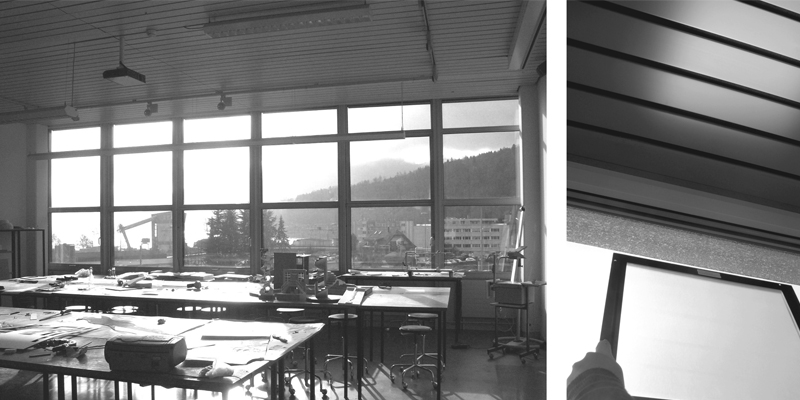Downloads
DOI:
https://doi.org/10.7480/jfde.2017.2.1738Keywords:
climate based daylight simulation, daylight metrics, photon mapping, radianceAbstract
The new calculation tool EvalDRC enhances current strategies for the simulation of Daylight Redirecting Components (DRCs). It is built upon RADIANCE as a core simulation engine and uses the daylight coefficient method, climate based sky models for annual simulations, and daylight metrics for data reduction. Contribution Photon Mapping is introduced as a new method for physically correct DRC simulation. Further new features are separate: True Sun Coefficients for a less approximated, more accurate treatment of the sun contribution and monthly breakdowns of the Spatial Daylight Autonomy and Annual Sunlight Exposure metrics for more detailed information about DRC performance over the course of the year. To show the versatility of the tool, two application studies were carried out in which either measured Bidirectional Scattering Distribution Functions (BSDF) or detailed geometry models were used for the DRC simulation.
How to Cite
Published
Issue
Section
License
Copyright (c) 2017 Carsten Bauer, Zehra Tugce Kazanasmaz, Stephen Wittkopf

This work is licensed under a Creative Commons Attribution 4.0 International License.
Authors or their institutions retain copyright to their publications without restrictions.
References
Apian-Bennewitz, P. (2010) New scanning gonio-photometer for extended brtf measurements. In Proc. SPIE, volume 7792, 77920O-77920O-20, 2010. Retrieved from: http://dx.doi.org/10.1117/12.860889
Bauer, C., Wittkopf, S., (2015) Annual Daylight Simulations with EvalDRC: Assessing the Performance of Daylight Redirection Components. Journal of Facade Design and Engineering, Vol. 3, no 3-4, pp. 253-272. DOI: 10.3233/FDE-160044
Bourgeois, C., Reinhart, C., Ward, G., (2008) Standard daylight coefficient method for dynamic daylighting. Building Research & Information, 36:68-82
Grobe, L., Noback, A., Wittkopf, S. and Kazanasmaz, T. (2015). Comparison of Measured and Computed BSDF of a Daylight Redirecting Component. In Proc. CISBAT 2015. DOI: 10.5075/epfl-cisbat2015-205-210
Heschong, L., van den Wymelenberg, K., Andersen, M., Digert, N., Fernandes, L., Keller, A., Loveland, J., McKay H., Mistrick, R., Mosher, B., Reinhart, C., Rogers, Z., Tanteri, M. (2012). Approved Method: IES Spatial Daylight Autonomy (sDA) and Annual Sunlight Exposure (ASE). IES standard LM-83-12. ISBN:978-0-87995-272-3.
Kazanasmaz,T., Grobe, L.O., Bauer, C. Krehel, M., Wittkopf, S. (2016) Three approaches to optimize optical properties and size of a South-facing window for spatial Daylight Autonomy. Building and Environment. pp. 243-256, DOI:10.1016/j.buildenv.2016.03.018
Krehel, M., K., Kämpf, J., Wittkopf, S. (2015), Characterisation and modelling of advanced daylight redirection systems with different goniophotometers. In Proc. CISBAT 2015. DOI: 10.5075/epfl-cisbat2015-211-216
McNeil, A., Lee, E. (2013). A validation of the radiance three-phase simulation method for modeling annual daylight performance of optically-complex fenestration systems. Journal of Building Performance Simulation. DOI: 10.1080/19401493.2012.671852
McNeil, A. (2013) The five-phase method for simulating complex fenestration. Tutorial. Retrieved from: http://www.radiance-online.org/learning/tutorials/fivephasetutorialfiles/Tutorial-FivePhaseMethod_v2.pdf
McNeil, A., Jonsson, C., Applefield, E., Ward G., and Lee, E. (2013). A validation of a ray-tracing tool used to generate bi-directional scattering distribution functions for complex fenestration systems. Solar Energy, 98 Part C (2013), pp.404-414
Reinhart, C., Herkel, S. (2000). The simulation of annual daylight illuminance distributions – a state-of-the-art comparison of 6 RADIANCE based methods. Energy and Buildings, 32, (2000), pp. 167-187
Schregle, R. (2004). Daylight simulation with photon maps. (PhD thesis, Universität des Saarlandes). Retrieved from: scidok.sulb.unisaarland.de/volltexte/2007/1171.
Schregle, R. (2015). Development and integration of the radiance photon map extension. (Technical Report, February 2015) Lucerne University of Applied Sciences and Arts. DOI: 10.13140/2.1.3332.9449
Schregle, R., Grobe, L.O., Wittkopf, S. (2016): An out-of-core photon mapping approach to daylight coefficients. Journal of Building Performance Simulation. DOI: 10.1080/19401493.2016.1177116
Tregenza, P. (1987). Subdivision of the sky hemisphere for luminance measurements. Lighting Res. & Technology. 19:13-14, 1987.
Wann Jensen, H. (2001). Realistic Image Synthesis Using Photon Mapping. Natick, MA, USA: A.K.Peters Ltd. ISBN: 1568811470
Ward, G., Mistrick, R., Lee, E., McNeil, A., Jonsson, C. (2011). Simulating the daylight performance of complex fenestration systems using bidirectional scattering distribution functions within radiance. (Technical Report LBNL-4414E) Lawrence Berkeley National Laboratory. Retrieved from: http://buildings.lbl.gov/publications/simulating-daylight-performance-compl
Ward, G., Kurt, M. Bonneel, N. (2012) A Practical Framework for Sharing and Rendering Real-World-Bidirectional Scattering Distribution Functions. (Technical Report LBNL-5954-E) Lawrence Berkeley National Laboratory.
